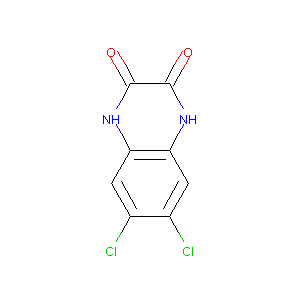Details of the Drug
General Information of Drug (ID: DMMX1QJ)
| Drug Name |
6,7-Dichloro-1,4-dihydro-quinoxaline-2,3-dione
|
||||||||||||||||||||||
|---|---|---|---|---|---|---|---|---|---|---|---|---|---|---|---|---|---|---|---|---|---|---|---|
| Synonyms |
25983-13-5; 6,7-Dichloroquinoxaline-2,3(1H,4H)-dione; DCQX; 6,7-dichloroquinoxaline-2,3-diol; 6,7-DICHLORO-1,4-DIHYDRO-2,3-QUINOXALINEDIONE; 6,7-dichloro-1,4-dihydroquinoxaline-2,3-dione; 2,3-Dihydroxy-6,7-dichloroquinoxaline; 6,7-Dichloro-1,4-dihydro-quinoxaline-2,3-dione; CHEMBL284028; Spectrum_001661; ACMC-209gnv; SpecPlus_000650; Lopac-D-133; AC1L1CDC; Spectrum5_001426; Spectrum4_000630; Spectrum3_001668; Spectrum2_000537; Biomol-NT_000181; AC1Q3Q7M; Lopac0_000418; KBioSS_002141; KBioGR_001220; BSPBio_003455; Benzil-related co
|
||||||||||||||||||||||
| Indication |
|
||||||||||||||||||||||
| Drug Type |
Small molecular drug
|
||||||||||||||||||||||
| Structure |
 |
||||||||||||||||||||||
| 3D MOL | 2D MOL | ||||||||||||||||||||||
| #Ro5 Violations (Lipinski): 0 | Molecular Weight (mw) | 231.03 | |||||||||||||||||||||
| Logarithm of the Partition Coefficient (xlogp) | 1.5 | ||||||||||||||||||||||
| Rotatable Bond Count (rotbonds) | 0 | ||||||||||||||||||||||
| Hydrogen Bond Donor Count (hbonddonor) | 2 | ||||||||||||||||||||||
| Hydrogen Bond Acceptor Count (hbondacc) | 2 | ||||||||||||||||||||||
| Chemical Identifiers |
|
||||||||||||||||||||||
| Cross-matching ID | |||||||||||||||||||||||
Molecular Interaction Atlas of This Drug
 Drug Therapeutic Target (DTT) |
|
||||||||||||||||||||||||||
|---|---|---|---|---|---|---|---|---|---|---|---|---|---|---|---|---|---|---|---|---|---|---|---|---|---|---|---|
| Molecular Interaction Atlas (MIA) | |||||||||||||||||||||||||||
